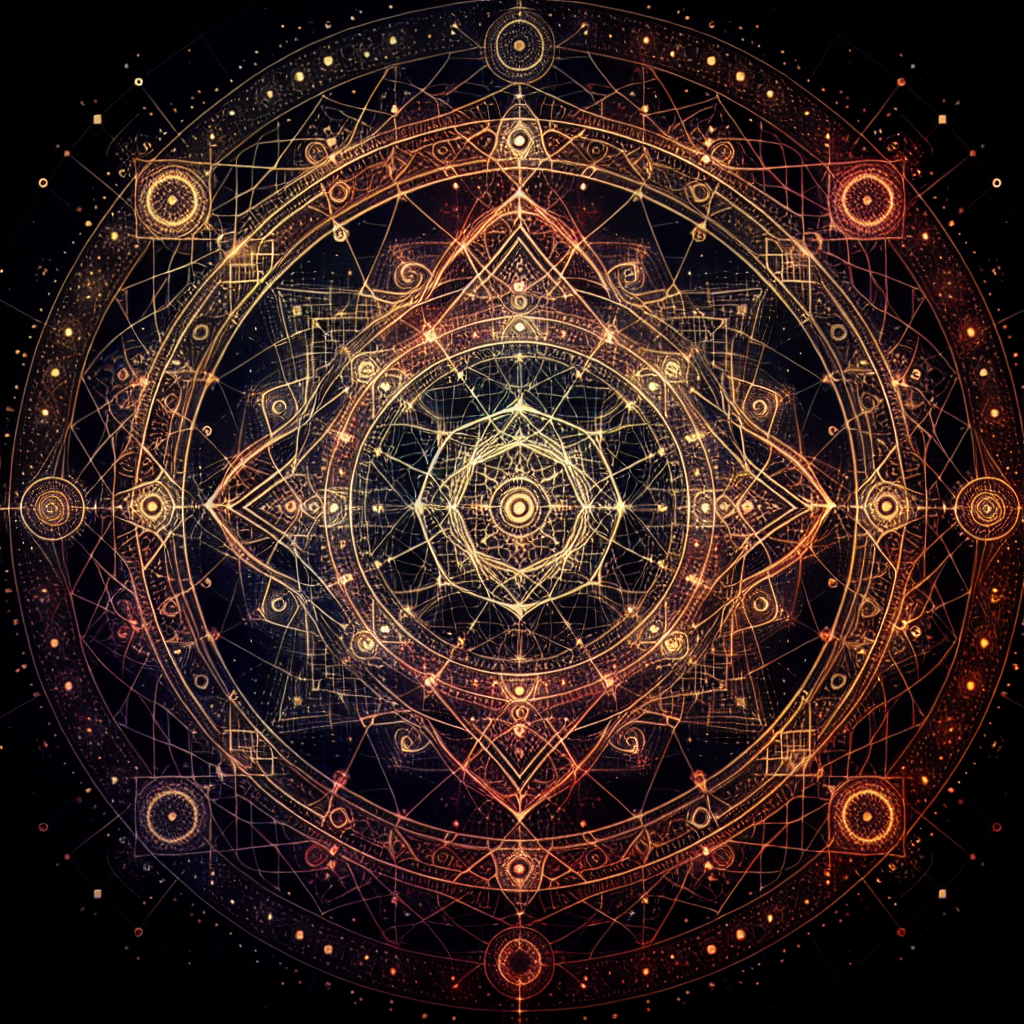Spiritual Devotional about Sacred Geometry
Discovering the Divine Blueprint: A Journey Through Sacred Geometry
Beloved friends,
Welcome to our spiritual oasis, where we find solace and inspiration from the divine mysteries woven into the fabric of our existence. Today, we embark on a fascinating journey to explore the realm of Sacred Geometry—a profound spiritual system that reveals the fingerprints of God in the structure of the universe.
Sacred Geometry is the study of geometric patterns that recur throughout nature and have been used in religious art and architecture for centuries. These patterns—like the Flower of Life, the Golden Ratio, and the Platonic Solids—carry powerful symbolism and spiritual significance, reflecting the inherent order and beauty of God’s creation.
The Divine Blueprint
Our journey begins with the understanding that Sacred Geometry is, in essence, the blueprint of creation itself. Just as an architect draws detailed plans before constructing a building, our Heavenly Father has woven geometric principles into the very essence of the cosmos. From the spiral patterns of galaxies to the microscopic structure of DNA, the divine hand can be seen at work.
Consider the words of Job 38:4-5, where God invites Job to ponder His craftsmanship: “Where were you when I laid the earth’s foundation? Tell me, if you understand. Who marked off its dimensions? Surely you know! Who stretched a measuring line across it?” In these verses, God speaks of His meticulous design, reminding us that every aspect of creation has been thoughtfully and lovingly crafted.
The Circle and Eternity
The circle is one of the most fundamental shapes in Sacred Geometry, symbolizing unity, wholeness, and infinity. It is no coincidence that the circle appears prominently in many spiritual traditions, including Christianity. The circle’s unending nature reflects God’s eternal presence and His unbroken covenant with us.
In Revelation 1:8, we are reminded of God’s eternal nature: “I am the Alpha and the Omega, the Beginning and the End,” says the Lord, “who is and who was and who is to come, the Almighty.” The circle, with no beginning and no end, perfectly symbolizes this divine truth.
The Flower of Life: A Symbol of Creation
Another captivating symbol in Sacred Geometry is the Flower of Life, an intricate pattern consisting of multiple overlapping circles. This symbol represents the interconnectedness of all life and the unfolding of creation. It serves as a reminder that we are all a part of a greater, divinely orchestrated tapestry.
Reflecting on the interconnectedness of life, let us recall Colossians 1:16-17: “For in Him all things were created: things in heaven and on earth, visible and invisible, whether thrones or powers or rulers or authorities; all things have been created through Him and for Him. He is before all things, and in Him all things hold together.” The Flower of Life exemplifies this divine connection, showing us that everything is made through and for Christ, and in Him, we are all wonderfully united.
The Golden Ratio: A Testament to Divine Harmony
The Golden Ratio, another key concept in Sacred Geometry, is a mathematical ratio found in the arrangement of leaves, the pattern of seashells, and even the proportions of the human body. This ratio, often denoted by the Greek letter phi (φ), epitomizes harmony and balance in creation.
Romans 1:20 beautifully illustrates how God’s invisible qualities are evident in the natural world: “For since the creation of the world God’s invisible qualities—his eternal power and divine nature—have been clearly seen, being understood from what has been made, so that people are without excuse.” The prevalence of the Golden Ratio in creation provides a tactile example of His divine nature and artistic genius.
Embracing Sacred Geometry in Our Spiritual Walk
As we contemplate these geometric wonders, we are reminded of God’s infinite wisdom and creativity. Sacred Geometry invites us to recognize the divine patterns in our lives and the world around us, encouraging us to look beyond the surface and appreciate the deeper, spiritual truths.
Let us take inspiration from these divine designs to live with intentionality and harmony. Just as each geometric shape fits perfectly within the grand tapestry of creation, so too does our lives hold a specific purpose in God’s plan. When we align ourselves with His divine order, we open ourselves up to experiencing His boundless love, grace, and wisdom.
In closing, may our hearts swell with awe and gratitude as we recognize the Sacred Geometry all around us. Let it serve as a constant reminder that we are beautifully crafted for a divine purpose. Remember, friends, you are part of God’s magnificent design—perfectly placed and infinitely loved.
Explore and dig up answers yourself with our BGodInspired Bible Tools! Be careful – each interaction is like a new treasure hunt… you can get lost for hours 🙂
Q&A about Sacred Geometry
Sure! Here are some questions and answers based on the concept of Sacred Geometry:
Q1: What is Sacred Geometry?
A1: Sacred Geometry refers to the study and application of the geometric patterns and shapes that are viewed as fundamental to the design of the universe. It explores the mathematical principles behind natural forms and phenomena, such as the shapes of celestial bodies, plant growth patterns, and crystal structures, considering these patterns to be imbued with spiritual significance.
Q2: How is the Flower of Life significant in Sacred Geometry?
A2: The Flower of Life is one of the most recognized symbols in Sacred Geometry. It consists of multiple evenly spaced, overlapping circles arranged in a flower-like pattern. It is said to represent the cycle of creation and the interconnectedness of all life. It is often considered a visual expression of the fabric of creation and is used in various spiritual and religious contexts.
Q3: What are Platonic Solids and how do they relate to Sacred Geometry?
A3: Platonic Solids are five unique geometric shapes where each face is the same regular polygon and the same number of polygons meet at each vertex. They include the tetrahedron, hexahedron (cube), octahedron, dodecahedron, and icosahedron. In Sacred Geometry, these shapes are believed to represent the fundamental structures of the universe and are associated with different elements—earth, air, water, fire, and ether/space.
Q4: Can you explain the significance of the Fibonacci Sequence in Sacred Geometry?
A4: The Fibonacci Sequence, where each number is the sum of the two preceding ones (0, 1, 1, 2, 3, 5, 8, 13, 21, …), is significant in Sacred Geometry because it is closely related to the Golden Ratio (approximately 1.618). This ratio appears in various natural phenomena, such as the arrangement of leaves, the branching of trees, the spiral patterns of shells, and even the proportions of the human body. It is seen as a fundamental characteristic of natural aesthetics and harmony.
Q5: What role does Sacred Geometry play in architecture?
A5: Sacred Geometry has played a significant role in the design and construction of many ancient and historical structures. It was used to create buildings that are believed to resonate with harmonious proportions and energies. Examples include the Egyptian pyramids, Gothic cathedrals, and Hindu temples. The principles of Sacred Geometry were applied to achieve spiritual and aesthetic harmony and to reflect the perceived divine order of the universe.
Q6: How is the concept of the Vesica Piscis used in Sacred Geometry?
A6: The Vesica Piscis is formed by the intersection of two circles where the center of each lies on the circumference of the other. This shape is often associated with the concept of duality and union, as well as the emergence of creation from a state of unity. In Sacred Geometry, it symbolizes the intersection of the spiritual and the material worlds and is often used as a foundational shape for other complex geometrical patterns.
Q7: Are there any modern applications of Sacred Geometry?
A7: Yes, modern applications of Sacred Geometry can be found in fields such as art, architecture, and meditation practices. Artists and architects might use Sacred Geometry to create aesthetically pleasing and harmonious designs. In spirituality and alternative health practices, geometric patterns are used in mandalas and meditation tools to help focus the mind and promote a sense of inner peace. Sacred Geometry principles are also explored in digital design and fractal patterns in contemporary art and technology.
Feel free to ask more questions or for further details on any specific element of Sacred Geometry!


